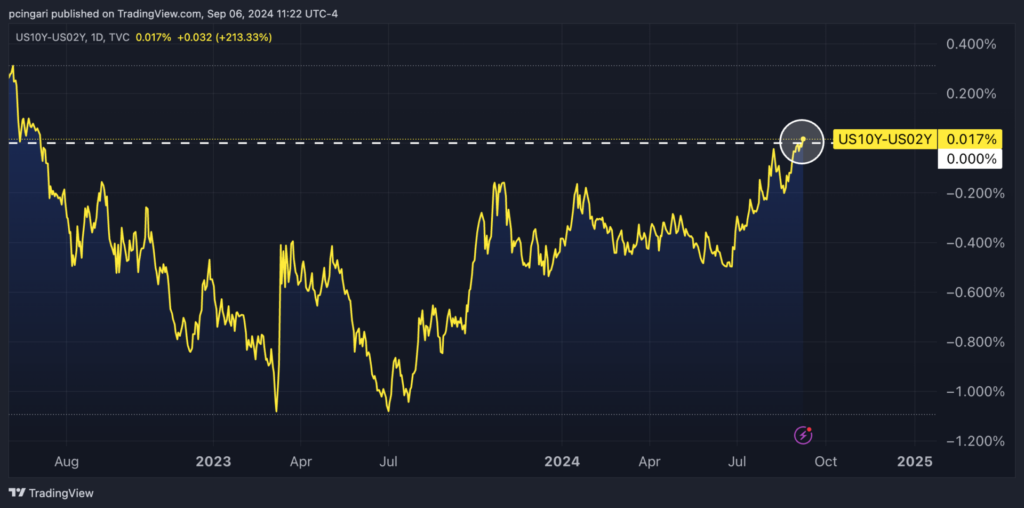Zinger Key Points
- U.S. Treasury yields fall sharply as August labor data misses expectations; traders increase bets on Fed rate cut.
- Market odds of a 50-basis-point rate cut surgee to 61%, overtaking a 39% chance of a 25-basis-point cut.
- China’s new tariffs just reignited the same market patterns that led to triple- and quadruple-digit wins for Matt Maley. Get the next trade alert free.
The U.S. Treasury market rallied sharply on Friday after August labor data showed weaker-than-expected job growth, bolstering bets on Federal Reserve interest rate cuts.
The U.S. economy added 142,000 nonfarm payrolls last month, an increase from 89,000 in July but missing the expected increase to 160,000. The unemployment rate ticked down by 0.1% to 4.3% as expected, while wages displayed higher-than-forecasted growth.
Market-implied odds of a 50-basis-point rate cut in September surged to 61% as of 11:05 a.m. in New York, overtaking the 39% probability of a 25-basis-point cut, according to the CME Group‘s FedWatch data.
September Rate-Cut Probabilities After August Jobs Data
| September Rate Cut | Now* | 1 day ago (Sept. 5, 2024) | 1 Week ago (Aug. 30, 2024) |
| 50 basis points (0.5%) | 61% | 40% | 30% |
| 25 basis points (0.25%) | 39% | 60% | 70% |
Traders poured into bonds amid growing expectations of declining interest rates, driving yields sharply lower across the Treasury curve.
The policy-sensitive two-year yield dropped over 10 basis points, reaching 3.59% at 11:15 a.m. in New York, its lowest level since March 2023.
The 10-year Treasury yield fell 6 basis points to 3.67%, marking its lowest point since June 2023.
This movement has led to a positive slope in the Treasury yield curve from the 10-year onward, effectively ending the more than two-year period of yield curve inversion.
Chart: US Yield Curve Normalizes, Ending 2-Year Inversion

Market Reactions
Rate-cut expectations and falling Treasury yields triggered sharp moves across asset classes, with bonds rallying, the dollar weakening against the yen and equity markets sliding.
“No sooner than the payroll print hit, the algorithms marched into high gear, pushing Treasury yields lower as the disappointing headline number, coupled with a series of downward revisions, suggested a more dire economic backdrop perhaps requiring a heavier dose of Fed medicine on Sept. 18,” said Quincy Krosby, chief global strategist for LPL Financial.
Markets are wrestling with whether the August payroll data signals a labor market returning to pre-COVID norms or an economy losing critical momentum, Krosby said.
- Treasury-related ETFs surged, with the iShares 20+ Year Treasury Bond ETF TLT rising 1.1% to $100.65, on pace for its highest close since late July 2023.
- The Japanese yen strengthened as well, with the Invesco CurrencyShares Japanese Yen Trust FXY gaining over 1%, poised to close at its highest level since early January 2024.
- Volatility spiked, as the CBOE Volatility Index (VIX) jumped 14% to 23.
- Wall Street flipped to the red, with the SPDR S&P 500 ETF Trust SPY dropping 1.5% on Friday, extending its weekly decline to 3.9%, on track for the worst weekly performance since March 2023.
- Tech stocks were hit hardest, with the Invesco QQQ Trust QQQ down 2.4%, pushing its weekly loss past 5%.
- Nvidia Corp. NVDA tumbled 4%, extending its weekly loss to 14%, its worst performance in two years.
Read Next:
Photo via Shutterstock.
Edge Rankings
Price Trend
© 2025 Benzinga.com. Benzinga does not provide investment advice. All rights reserved.
Trade confidently with insights and alerts from analyst ratings, free reports and breaking news that affects the stocks you care about.